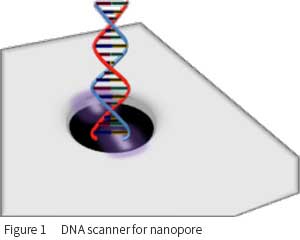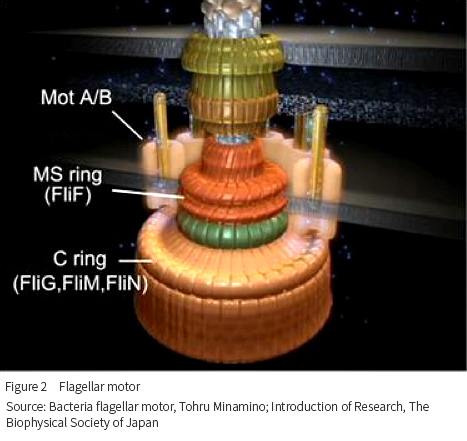Analyzing the behavior of living organisms at the atomic and molecular level—This is what nanobiotechnology, my specialized area of research, is about. It is a new research field that has emerged as a fusion of nanotechnology, which has been rapidly advancing in recent years, and biotechnology, in which various knowledge has been accumulated over many decades.
Nanotechnology is a technology used to manipulate matter at the nanometer (one billionth of a meter) scale—or at the scale of atoms and molecules—as desired to create new materials and add new functions to devices.
The concept of nanotechnology was born in 1959, when Richard Feynman, a US physicist and a laureate of the Nobel Prize in Physics, gave a lecture entitled “There’s Plenty of Room at the Bottom” to the American Physical Society and pointed out the possibility of manipulating individual atoms and molecules. Nanotechnology then made great advances when the scanning tunneling microscope (STM) was invented in 1981, which enabled the direct observation of atoms and molecules. In 1990, using an STM, IBM Research–Zurich succeeded in moving atoms individually to form the shape of three letters: I, B, M. Although it was still far from the commercialization stage, this research proved that it is theoretically possible to assemble individual atoms in defined ways.
At that time, I was studying at the University of Minnesota as a physics research assistant. While there, I spent six years building an STM by myself and used it to successfully develop an aluminum nano-structure, which resulted in the publication of papers and other research achievements. This experience led me to think that I could use the technology to start a new research study that could become my life’s work. And, after pondering long and hard over what to do, I came up with the idea of studying the “mystery of living organisms.”
In nanotechnology research, various techniques are used to combine molecules, but even connecting only two molecules together requires a great deal of time. However, in the case of living organisms, their atoms and molecules bond together naturally. This mechanism was very mysterious for me. I therefore decided to take on the new challenge of analyzing vital phenomena by making use of the STM techniques I had accumulated for observing atoms and molecules in the area of nanotechnology.
This coincided with me finding a group at the Department of Molecular and Cellular Biology at Harvard University that was conducting research that combines nanotechnology and molecular biology. I applied for their open recruitment of researchers and joined the group to continue my research at Harvard University. This was my first encounter with nanobiotechnology.
What kind of research is being conducted at the forefront of nanobiotechnology? Let me introduce one example.
In the world of biophysics, the mechanism of living organisms at the atomic and molecular level is being clarified. The present findings include the double helix structure of DNA, which carries genetic information, and the four bases (adenine, thymine, guanine, and cytosine), the combination of which determines the character of a gene. The full genetic information of living organisms (genome) is also being unveiled. DNA looks like a long, soft string. A strand of human DNA is about two nanometers in diameter, and the total length of DNA contained in a cell reaches as long as two meters if connected into one string.
In recent years, it has been said that a strand of DNA can be analyzed at the single molecule level by passing it through a very small, man-made pore with diameter of several nanometers (nanopore). This nanopore technology is expected to be useful as a new approach that will increase the efficiency of DNA base sequencing. Nanopore technology can function as a “DNA scanner” (See Fig. 1).

With existing DNA analysis techniques often used at present, DNA has to first be replicated before it is subjected to statistical analysis. This technique carries with it some problems because, for instance, it requires many time-consuming DNA replication reactions before analysis, as well as the use of special reagents.
On the other hand, nanopore technology makes it possible to do gene sequencing with only a single strand of DNA, requiring no burdensome replication operations. The decoding speed is estimated to be one millisecond (a 1,000th second) per base or faster. All 3 billion human DNA base pairs can be analyzed in about one day if multiple sequencers are used in parallel. The technology is also effective in reducing cost because it does not require the use of special reagents.
With this new analysis technology, people can even equip their smartphone with a small special sequencer and store their own DNA data. The technology is expected to not only lead to the early detection of diseases, but also to contribute to the development of new drugs and advances in regenerative medicine.
However, current nanopore technology is not able to read a strand of human DNA, which is about two meters long in total, at one time. It is essential to define an optimal environment for the analysis by, among other ways, identifying the ingredients of a solution that will cause entangled DNA strands to straighten and facilitate their injection into nanopores, and determining what level of electrical stimulation should be given. This is what our current research is focusing on.
From observations of the biological activity of living organisms at the atomic and molecular level, it has been found that, amazingly, everything is perfect without any errors.
Driven by my desire to meet the challenge of analyzing vital phenomena by leveraging the techniques I accumulated for observing atoms and molecules, I have expanded the scope of my research into directly studying cells. The structure of a cell is perfect, with no waste. The sophistication of the system is evident in the mechanism of a bacterial “flagellar motor,” which was revealed by Dr. Keiichi Namba, graduate school professor at Osaka University.
Escherichia coli or E. coli swims in water by rotating its spirally coiled flagella at a high speed. The rotation speed reaches as fast as 300 rotations per second. Nevertheless, unlike an automobile engine, E. coli does not generate any heat, meaning that almost no energy is lost. Considering their amazingly small size of about 30 nanometers, they are—as Dr. Namba says—“the smallest yet most powerful motor in nature” (See Fig. 2). The flagellar motor consists of protein complex molecules called MotA/B, MS ring, and C ring, each of which works as an indispensable part of the whole motor. If any of the parts are missing, the flagella cannot function as a motor.
When I observed the structure of the flagellar motor for the first time, I was amazed by its perfection. Living organisms are thus able to develop tiny yet sophisticated systems for themselves with ease by virtue of their self-organizing ability.

What I want to do is to study the perfect structures of living organisms, such as E. coli’s flagellar motor, and try to replicate them artificially.
There are many unsolved questions at the root of life science. However, I am certain that the development of nanobiotechnology will lead to unravelling them in the near future. My aim in my research is to discover something that will result in textbooks being rewritten. I hope that you will also constantly ask yourself if the knowledge you take for granted now is really true without being bound by past common knowledge. This kind of attitude will make science more exciting.
(This column is as of 2015.)